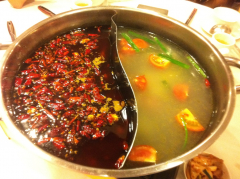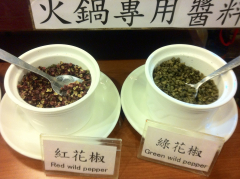Media
HKU Chemists Synthesize Chemical Component of Sichuan Peppers that Causes Numbing Sensation of Eaters
14 Sep 2012
Where do you find inspiration? Associate Professor Patrick H. Toy (Department of Chemistry, The University of Hong Kong) and his co-workers find it all around them, even at the dinner table. During a Sichuan hot-pot dinner, he and his research team wondered what it is about such meals that they like so much. They soon found that the pleasurable tingling sensation and numbing of tongue and lips felt when eating Sichuan peppercorns (huajiao) is caused by the chemical hydroxy-alpha-sanshool (HAS). They subsequently synthesized HAS and the results of this research have been published recently in the journal SYNLETT.
While the identity and structure of this compound had been known for quite a while, its biological activity has only recently begun to be studied in great detail. However, one factor currently limiting research regarding HAS is the difficulty in obtaining it in a highly pure form. While huajiao is cheap and widely available, isolating pure HAS from it is difficult, expensive and low-yielding. For example, 1 kilogram of dry huajiao only affords approximately 1 gram (0.1%) of HAS pure enough for research purposes after repetitive purifications. Thus, isolating pure HAS is sort of like picking needles out of a haystack!
HAS possesses a relatively simple structure and Dr Toy and his co-workers felt that the supply limitations could be overcome by synthesizing it from scratch, rather than isolating it from plant sources. Recently they have accomplished this feat using several widely available and inexpensive starting materials in a process that only requires half a dozen reactions and that can be performed in a few days. Their method for producing HAS not only provides access to large quantities of it in high purity, but it also allows for the synthesis of analogues of HAS for use in what are known as “structure-activity-relationship studies” that may identify more potent compounds.
Researchers around the world are currently studying the use of HAS in applications ranging from medicine (as a topical pain killer) to cosmetics (as a potent skin lifter), and the methodology developed by Dr Toy and co-workers should greatly facilitate this work. They even envision using their synthetic HAS in candy that provides the pleasant effects of eating huajiao, but that does not contain its bitter components, and are currently pursuing this idea.
The research paper can be viewed at: https://www.thieme-connect.com/ejournals/abstract/10.1055/s-0032-1317172
SYNLETT is an international journal reporting research results and trends in synthetic organic chemistry in short personalized reviews and preliminary communications. It covers all fields of scientific endeavor that involve organic synthesis. For details, please visit: http://www.thieme-chemistry.com/en/products/journals/synlett.html
For press enquiry, please contact Ms Cindy Chan, Communication Manager of Faculty of Science, at 2241-5286/ 6703-0212 or by email at cindycst@hku.hk; or Dr Patrick H Toy, Associate Professor of Department of Chemistry at phtoy@hku.hk
Sichuan peppercorn (huajiao) is the main character of Sichuan hot-pot, of which the HAS it contains can stimulate tingling sensation and numbing of tongue and lips.



